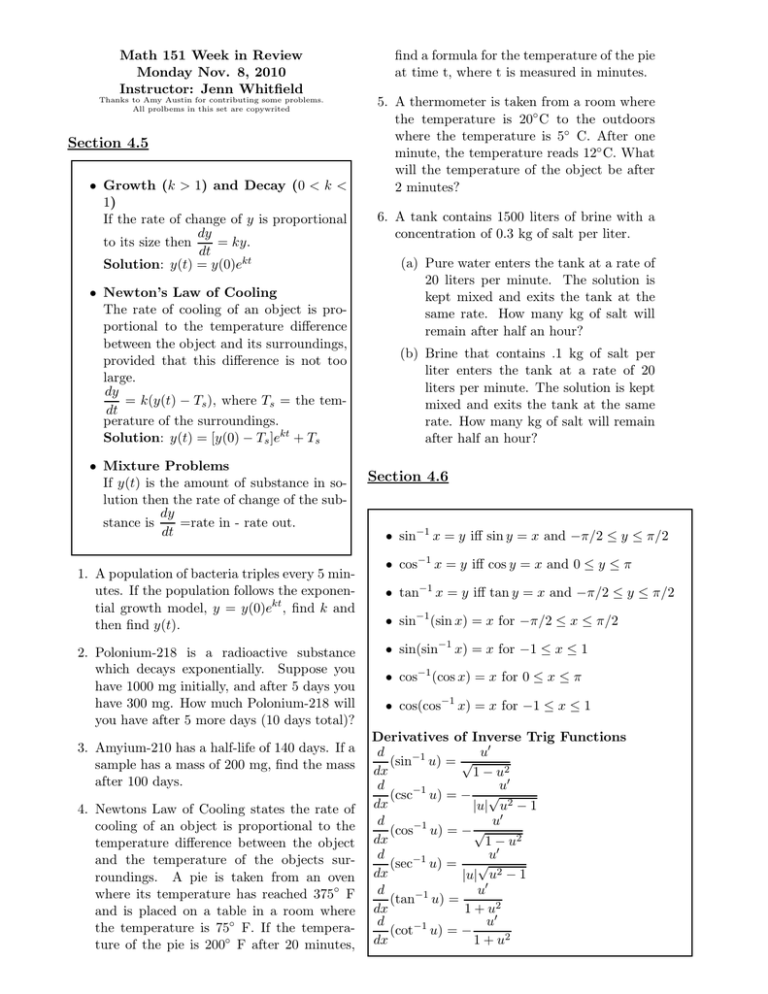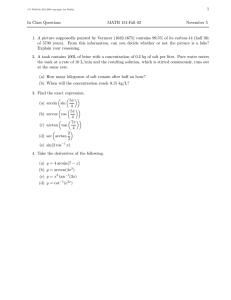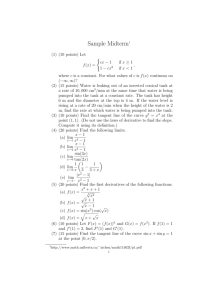Math 151 Week in Review Monday Nov. 8, 2010
advertisement

Math 151 Week in Review Monday Nov. 8, 2010 Instructor: Jenn Whitfield Thanks to Amy Austin for contributing some problems. All prolbems in this set are copywrited Section 4.5 • Growth (k > 1) and Decay (0 < k < 1) If the rate of change of y is proportional dy = ky. to its size then dt Solution: y(t) = y(0)ekt • Newton’s Law of Cooling The rate of cooling of an object is proportional to the temperature difference between the object and its surroundings, provided that this difference is not too large. dy = k(y(t) − Ts ), where Ts = the temdt perature of the surroundings. Solution: y(t) = [y(0) − Ts ]ekt + Ts • Mixture Problems If y(t) is the amount of substance in solution then the rate of change of the subdy =rate in - rate out. stance is dt 1. A population of bacteria triples every 5 minutes. If the population follows the exponential growth model, y = y(0)ekt , find k and then find y(t). 2. Polonium-218 is a radioactive substance which decays exponentially. Suppose you have 1000 mg initially, and after 5 days you have 300 mg. How much Polonium-218 will you have after 5 more days (10 days total)? 3. Amyium-210 has a half-life of 140 days. If a sample has a mass of 200 mg, find the mass after 100 days. 4. Newtons Law of Cooling states the rate of cooling of an object is proportional to the temperature difference between the object and the temperature of the objects surroundings. A pie is taken from an oven where its temperature has reached 375◦ F and is placed on a table in a room where the temperature is 75◦ F. If the temperature of the pie is 200◦ F after 20 minutes, find a formula for the temperature of the pie at time t, where t is measured in minutes. 5. A thermometer is taken from a room where the temperature is 20◦ C to the outdoors where the temperature is 5◦ C. After one minute, the temperature reads 12◦ C. What will the temperature of the object be after 2 minutes? 6. A tank contains 1500 liters of brine with a concentration of 0.3 kg of salt per liter. (a) Pure water enters the tank at a rate of 20 liters per minute. The solution is kept mixed and exits the tank at the same rate. How many kg of salt will remain after half an hour? (b) Brine that contains .1 kg of salt per liter enters the tank at a rate of 20 liters per minute. The solution is kept mixed and exits the tank at the same rate. How many kg of salt will remain after half an hour? Section 4.6 • sin−1 x = y iff sin y = x and −π/2 ≤ y ≤ π/2 • cos−1 x = y iff cos y = x and 0 ≤ y ≤ π • tan−1 x = y iff tan y = x and −π/2 ≤ y ≤ π/2 • sin−1 (sin x) = x for −π/2 ≤ x ≤ π/2 • sin(sin−1 x) = x for −1 ≤ x ≤ 1 • cos−1 (cos x) = x for 0 ≤ x ≤ π • cos(cos−1 x) = x for −1 ≤ x ≤ 1 Derivatives of Inverse Trig Functions d u′ (sin−1 u) = √ dx 1 − u2 u′ d (csc−1 u) = − √ dx |u| u2 − 1 d u′ (cos−1 u) = − √ dx 1 − u2 u′ d √ (sec−1 u) = dx |u| u2 − 1 d u′ (tan−1 u) = dx 1 + u2 d u′ (cot−1 u) = − dx 1 + u2 Compute the following without the aid of a calculator. 1 7. arcsin 2 x→∞ x→0 2π ) 3 4 13. sin arccos(− ) 5 14. cos(arctan x) 5π ) 4 16. Find the derivative of y = arctan √ x 17. Find the equation of the tangent line to the x graph of y = arcsin at x = 1. 2 18. What is the domain of f (x) = arcsin(2x − 1)? Section 4.8 INDETERMINANTE FORMS 0 ∞ 0 • ∞ ∞ − ∞ 00 ∞0 0 ∞ 1∞ L’Hospital’s Rule: Suppose f and g are differentiable and g′ (x) 6= 0 on an open interval I that contains a (except possible at a). Suppose that lim f (x) = 0, lim g(x) = 0, or that x→a x→a lim f (x) = ±∞, lim g(x) = ±∞. Then x→a x→a f ′ (x) f (x) = lim ′ lim x→a g (x) x→a g(x) Find the following limits using L’Hospital’s rule. 19. lim x→1 20. lim x→0 ln x x−1 sin x − x x3 (ln x)3 x→∞ x2 √ 22. lim x ln x 21. lim x→0+ 3 1+ x x 25. lim (sin x)tan x 11. tan−1 (−1) 15. arccos(cos x→∞ 24. lim 1 8. arccos √ 2 √ 3 9. sin−1 (− ) 2 √ 10. arctan 3 12. arctan(tan 4 23. lim x x








